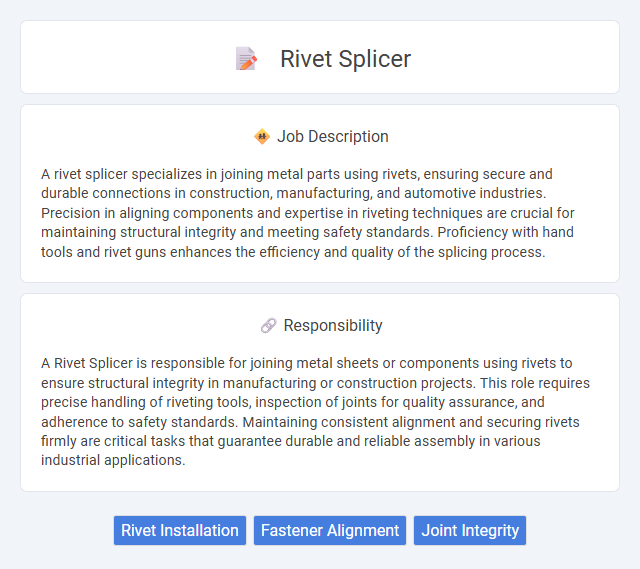
A rivet splicer specializes in joining metal parts using rivets, ensuring secure and durable connections in construction, manufacturing, and automotive industries. Precision in aligning components and expertise in riveting techniques are crucial for maintaining structural integrity and meeting safety standards. Proficiency with hand tools and rivet guns enhances the efficiency and quality of the splicing process.
Individuals with good hand-eye coordination and manual dexterity are likely to be well-suited for a rivet splicer job, as it requires precise handling of tools and materials. Those who can maintain focus for extended periods and tolerate physically demanding tasks may find this role suitable. People with a preference for repetitive tasks in a stable work environment might have a higher probability of thriving in this occupation.
Qualification
A rivet splicer requires proficiency in operating specialized machinery to join metal pieces using rivets, emphasizing precision and safety compliance. Essential qualifications include a high school diploma or equivalent, hands-on experience with rivet tools, and knowledge of metalworking processes. Certification in welding or metal fabrication significantly enhances job prospects and technical competence in this skilled trade.
Responsibility
A Rivet Splicer is responsible for joining metal sheets or components using rivets to ensure structural integrity in manufacturing or construction projects. This role requires precise handling of riveting tools, inspection of joints for quality assurance, and adherence to safety standards. Maintaining consistent alignment and securing rivets firmly are critical tasks that guarantee durable and reliable assembly in various industrial applications.
Benefit
A Rivet Splicer job likely offers a stable career path with consistent demand in manufacturing and construction industries. Employees in this role probably benefit from developing specialized skills in metal fastening techniques, which can enhance employability. Safety protocols and teamwork within these jobs may also contribute to a secure and cooperative work environment.
Challenge
Rivet splicer jobs likely involve the challenge of ensuring precise alignment and secure fastening under tight tolerances, which may require strong attention to detail and manual dexterity. Workers probably face time constraints and repetitive tasks that test their focus and stamina. Safety risks might be present due to handling heavy materials and operating machinery, increasing the need for vigilance.
Career Advancement
A rivet splicer plays a crucial role in assembling and repairing metal components by securely fastening rivets to ensure structural integrity. Mastery of rivet splicing techniques opens pathways to advanced positions such as lead technician, quality control inspector, or manufacturing supervisor in industrial and aerospace sectors. Gaining certifications in welding, metal fabrication, and safety compliance further accelerates career growth and opportunities for higher earning potential.
Key Terms
Rivet Installation
Rivet splicer jobs primarily involve the precise installation of rivets to join metal sheets, ensuring structural integrity and durability in manufacturing processes. Expertise in selecting appropriate rivet types, sizes, and materials is critical for optimal load-bearing performance and preventing component failure. Skilled rivet installation directly impacts the quality and longevity of assembled products in aerospace, automotive, and construction industries.
Fastener Alignment
Fastener alignment in a rivet splicer job is critical to ensure precise joining of materials, reducing defects and improving joint strength. Proper alignment mechanisms and calibrated fixtures optimize positioning accuracy, leading to consistent rivet placement and enhanced production efficiency. Advanced rivet splicers integrate sensors and alignment guides to maintain consistent fastener orientation, minimizing rework and material waste.
Joint Integrity
Rivet splicers ensure joint integrity by precisely aligning and fastening metal components with rivets, creating strong, durable bonds critical in aerospace, automotive, and construction industries. Their expertise in selecting the appropriate rivet type and applying correct fastening techniques minimizes structural weaknesses and prevents joint failure under stress. Regular inspection and maintenance of riveted joints further guarantee long-lasting performance and safety in high-stress applications.
 kuljobs.com
kuljobs.com